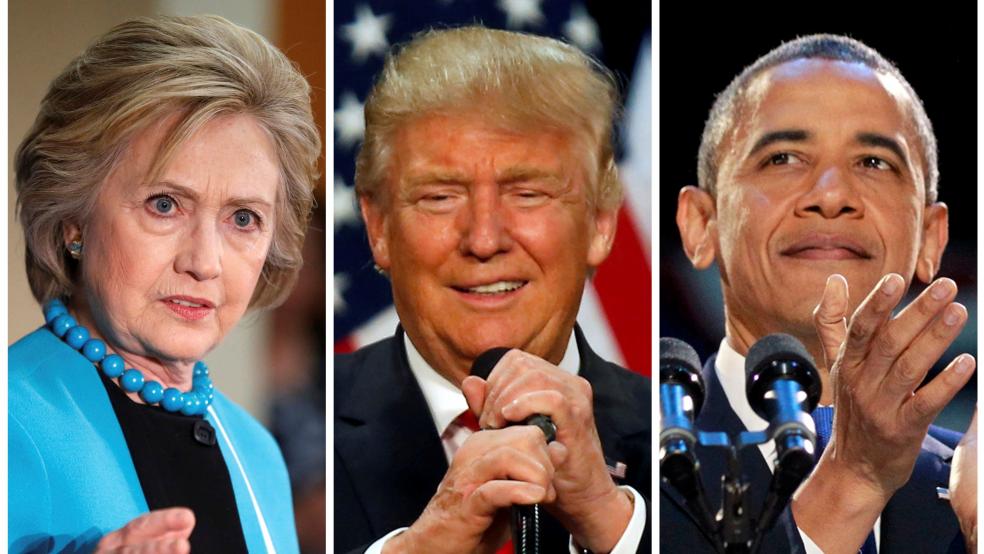President Obama and Donald Trump have this in common: both have created a personal brand that tops achievement and defies critics. Obama’s appealing image has won him high approval ratings, in spite of multiple administration scandals and a solid record of underachievement. For Trump, a powerful brand has made him a contender, against all odds.
President Obama sees the parallels and is becoming frantic. In a remarkable cri de coeur, he recently told black Americans he would “consider it a personal insult” if they don’t vote for Hillary Clinton. He has taken to calling Donald Trump a bigot and has said the GOP contender is “unfit to serve.” At the same time, he has become the Energizer Bunny, creating a controversial national monument in Maine, signing into law a GMO labeling bill, freeing dangerous terrorists from Guantanamo, pardoning convicts, creating the first Atlantic marine sanctuary, adding new regulations on industry and more.
Related: Are the Trump Kids Becoming Political Liabilities?
The cause of this frenetic activity? Obama is worried his entire legacy will be undone by Donald Trump, and is desperate to have more to show for his presidency. His anxiety has been fueled by tightening polls, but also the recognition that the GOP candidate has what Obama had four years ago – a near-cult following immune to facts or information.
When the president says, “I don’t think the guy’s qualified to be president of the United States,” he mimics his critics of eight years ago. They were right. A candidate with few achievements, both in his brief political career or in his years as a community organizer and law professor, Obama campaigned on hope and change. That’s what Trump is doing, and it’s working for him, just as it did for Obama eight years ago.
Hillary Clinton, meanwhile, is struggling. She may ultimately win this joyless slugfest thanks to a huge money advantage, but she has been utterly incapable of co-opting Obama’s popularity. It is not just that her personality is brittle and unwelcoming – that she is not especially “likable;” it is that Obama’s brand is not something he can share, though he is desperate to do so.
The Obama White House has worked non-stop to protect the president’s brand through careful message management. Throughout the past seven-plus years, Obama has blamed poor communications for his administration’s shortcomings. In late 2015, the president said his low marks on underestimating ISIS were due to poor messaging.
Related: Terror Attacks Trigger a ‘Sticks and Stones’ Battle Between Trump and Clinton
After being clobbered in the 2014 election, Obama said his administration had done a poor job of communicating his achievements. Faced with criticism for having backtracked on his “red line” in Syria, the president said his plan had not been “packaged” properly. Of the shortcomings in his first term, Obama said, “But the nature of this office is also to tell a story to the American people…”
To Obama’s circle, the story is everything. A couple of days ago, White House spokesperson Josh Earnest claimed that we are in a “narrative fight” with ISIS. It was an insulting description of a conflict in which innocents have been burned in cages and mowed down by machine guns, but not an unreasonable one from a White House that has governed by narrative, many of them false.
The prevailing “narratives” about Obamacare – that it would bring down healthcare costs and that you could keep your existing plan if you liked it – were false. The narrative spun about the Iran deal – that a “moderate” regime promised better relations with the West – was also untrue.
To the fury of Republicans who view him as a failed president, Obama remains a popular figure with an average approval rating of 52 percent, according to Gallup. Though on average Obama’s approval ratings are below the average for all U.S. presidents, (47 percent for his entire term vs. 53 percent), at this point in his time in office he is outperforming his predecessors. Considering that many of his legacy ambitions are on the rocks or held up by the courts, that’s a remarkable achievement.
Related: Johnson Says the GOP and Democrats Are ‘Dinosaurs’ Headed for Extinction
It is also remarkable since a majority of Americans profess their admiration for President Obama while at the same time, 55 percent say in a recent CBS poll that they want “big changes and we need to rethink just about everything” in the next few years. How does that compute?
How has the president managed to stay popular even as Obamacare is imploding, the Iran deal is unraveling, his immigration efforts have stalled, and he has to embrace an unpopular would-be successor? It is because his brand is, for the most part, untarnished. He has a “cool” image and an attractive family, and by comparison to those who would succeed him, he looks pretty good. To protect his brand, he has lofted one narrative after another to excuse and explain his shortcomings, and Americans have accepted the story.
His principle line of defense for seven years has been that Republicans in Congress have prevented him from doing all the things he promised. According to the long-running story, that’s why we have not achieved immigration reform, stricter gun control, reduced income inequality, changed our education system for the better, adopted a broader climate agenda, made our entitlement programs more sustainable and so on. The president has left a lot of unfinished business. But, to hear the White House tell it, with the full support of the media, the GOP is to blame.
Voters aren’t so sure. While most exonerate Obama, they are underwhelmed by Hillary Clinton’s promise of four more years of Obama’s policies. Millions are still looking for hope and change; ironically, this time around that may lead them to Donald Trump.






